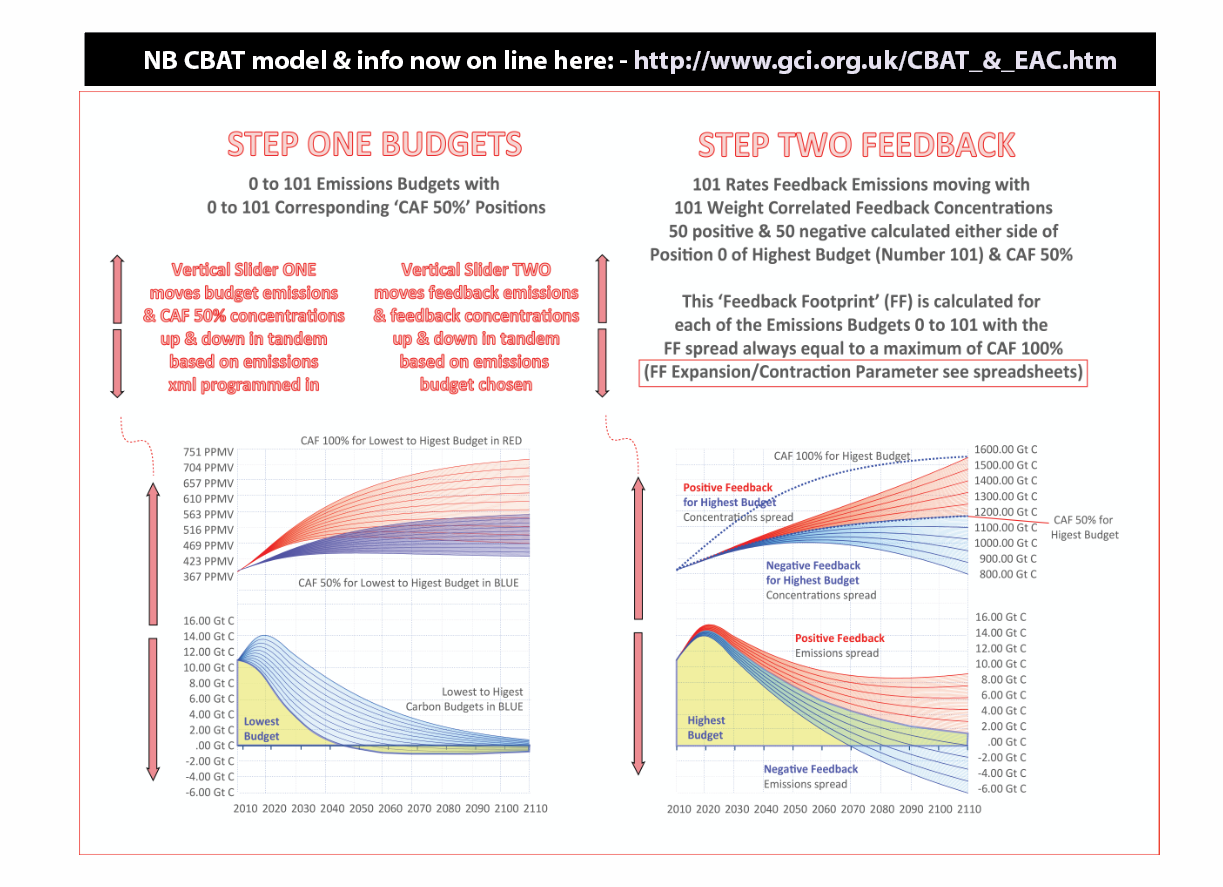Historically an average of just under 50% of emissions has been retained in the atmopshere and accumulated there. From this a 'CAF Frame of Reference' is created in CBAT.
CAF Frame of Reference in CBATA CAF 'Frame of Reference' is used in CBAT for each of the carbon-budgets calculated in CBAT as [a] CAF at 100% & [b] CAF at 50% & [c] CAF at 0% of carbon-budget-emissions.
This provides a constant quantitative 'Frame of Reference' for the potential +/- Feedback Concentrations consequent on the potential +/- Feedback Emissions where . . .
- the bigger the carbon-budget [d] the higher that CAF 50% & CAF 100% rise & [e] the bigger the spread of potential feedback concentrations or
- the smaller the carbon-budget [f] the lower that CAF 50% & CAF 100% rise & [g] the smaller the spread of potential feedback concentrations (click image to enlarge).
Carbon BudgetA carbon budget in CBAT is the combination - or 'shaping' - of two things: - [a] the 'path' year-to-year of the 'flow' of emissions over a given time-frame (2010-2110 in CBAT) and
[b] the 'integral' or the total weight (in Gt C) of that flow. Sizing & sharing that 'path-integral' of emissions gives the rate & weight of the 'carbon-budget'.
For this budget to be in compliance with the objective of the UNFCCC, it has to be fast-enough and small-enough, as safe and stable concentrations are still primarily a function of budget-emissions. The range of carbon-budgets programmed into CBAT (weighing from 197 Gt C to 593 Gt C) is shown here in yellow & blue (click to enlarge): -Climate SensitivityThe convention of 'Climate Sensitivity' is the 'termperature response' to a given increase in the concentrations in the global atmosphere.
It is handled in CBAT on a sliding scale like this
ConcentrationsContentContractionContentConvergenceContentConversionIn CBAT Contraction & Conversion to Renewables will soon be on-line. Renewable energy sources are classed in two groups
- a 'rainbow' of renewables: - Earth/Bio; Wind; Solar; Water; Wave and
- Nuclear
These replace fossil fuels at rates that are theoretically determined by the 'carbon-budget' user-chosen for UNFCCC-compliance with the Vertical Budget Slider in Domain One.
Depending on a range of factors, with a user-slider-control nuclear has a bigger or a smaller role to play, as suggested in what for now is a dummy image here & pdf file hereDamages
Domain
Equivalence
Evolution
Evolition
Feedback
Growth
Gt C
pH
PPMV
Pythagoras
Rate
The Carbon Budget Accounting Tool (CBAT)(work in progress - Best Viewed in a CHROME Browser) Back to homepage
- Notes (how it works)
- Narrative (how we got here)
- Nudges (how others see it)
- Glossary (all under construction)

